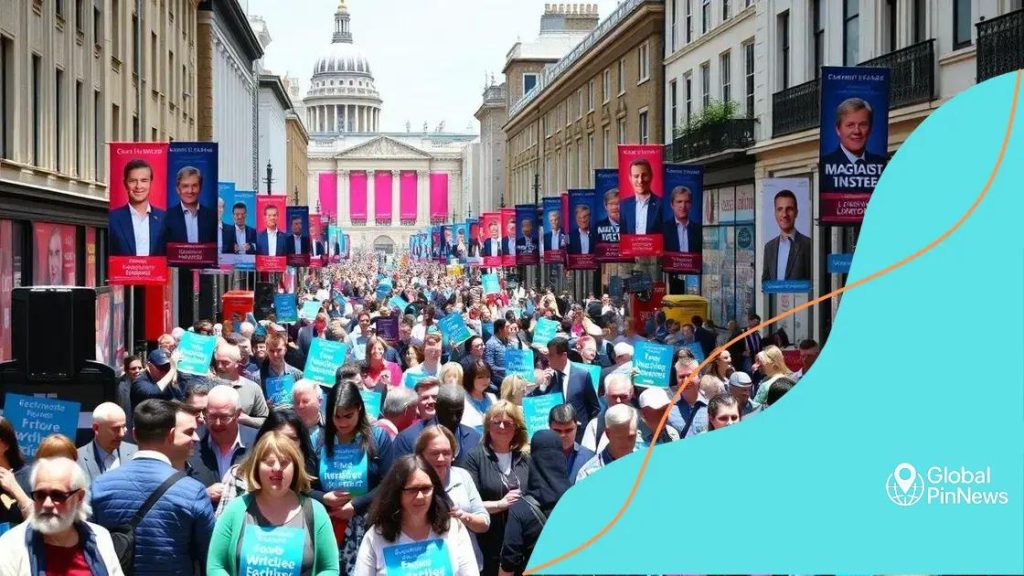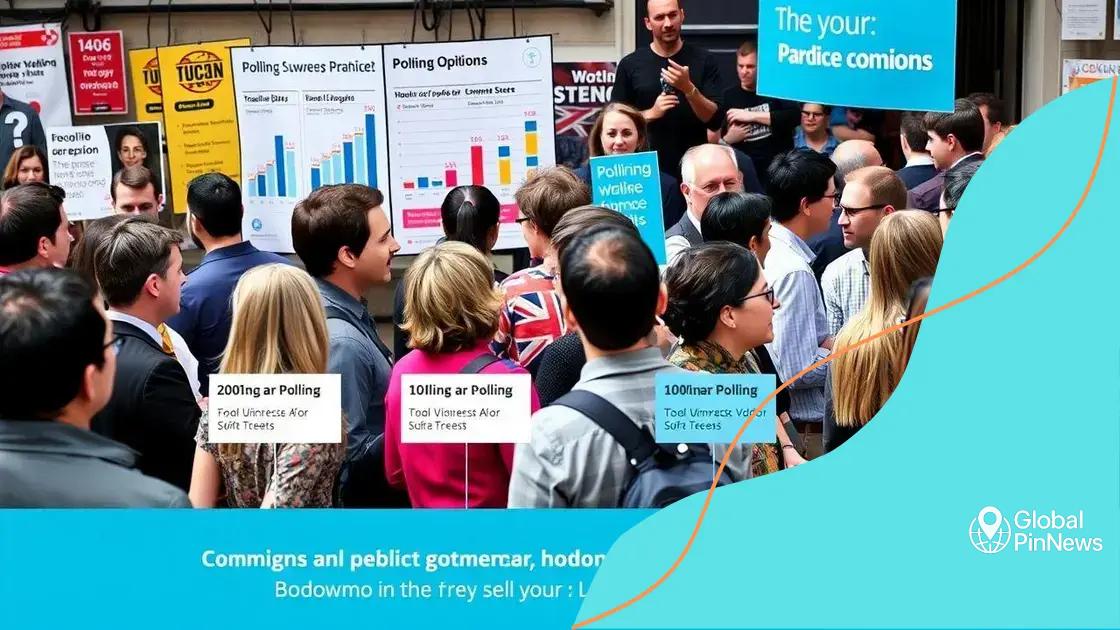Londonmayoralrace: key players and what to watch

The London mayoral race focuses on critical issues like housing affordability, transportation improvements, and sustainability, which will shape the future policies and community engagement post-election.
The Londonmayoralrace is heating up, and voters are keeping a close eye on the developments. With several candidates vying for attention, it’s essential to understand the dynamics at play and the implications for the city.<\/p>
Who are the main candidates in the London mayoral race?
In the Londonmayoralrace, several candidates are stepping into the spotlight, each bringing their unique perspectives and policies. Understanding who they are can help voters make informed choices. The upcoming election is crucial for the future of London, and the candidates’ platforms will significantly shape city governance.
Key Players in the Race
Among the many candidates, a few stand out due to their experience and public support. Here are some of the main contenders:
- Candidate A: Known for their focus on affordable housing and climate policies.
- Candidate B: A seasoned politician advocating for public transport improvements.
- Candidate C: An independent candidate pushing for more community involvement in decision-making.
- Candidate D: A young candidate emphasizing youth engagement and innovation.
Each candidate faces challenges as they campaign to connect with diverse Londoners. How they address local issues will be critical. Candidate A, for instance, has proposed to develop programs that aim to make housing more inclusive. Meanwhile, Candidate B stresses the importance of reliable transportation, which affects many residents’ daily lives.
Voter Reactions and Support
As the race heats up, public opinions about these candidates are evolving. Polls indicate that Candidate A is gaining momentum among younger voters eager for change. Candidate B has traditionally had a strong base among older demographics thanks to their track record. However, the emergence of candidates like C and D has introduced exciting new narratives into the race.
Ultimately, the Londonmayoralrace is not just about who gets elected, but how the candidates engage with the community. Monitoring their campaigns will reveal their potential impact on the future of London.
Key issues impacting the London mayoral election
Several key issues are shaping the upcoming Londonmayoralrace. Understanding these challenges is essential for voters as they assess candidates’ platforms. Each issue reflects the needs and concerns of Londoners, highlighting what they expect from their future leaders.
Housing and Affordability
One of the most pressing issues is housing. Many Londoners struggle to find affordable homes. Candidates often propose policies to increase housing supply or modify zoning laws.
- Increased investment in social housing.
- Regulation of rental prices.
- Support for first-time home buyers.
These proposals aim to alleviate the housing crisis and make living in London more accessible.
Transportation and Infrastructure
Another critical concern is public transportation. London’s transport system is vast but often overcrowded. Candidates are looking to enhance services and reduce fares to improve daily commutes.
Efforts to modernize transport will focus on:
- Expanding bike lanes to promote sustainable travel.
- Investing in electric buses for greener options.
- Enhancing accessibility for those with disabilities.
By addressing these transport issues, candidates aim to create a more efficient and environmentally friendly system.
Climate Change and Sustainability
Climate change is a significant challenge faced globally, and London is no exception. There are ongoing discussions about how to make the city more resilient to climate impacts.
Key initiatives often include:
- Reducing carbon emissions in public transport.
- Increasing green spaces throughout the city.
- Encouraging renewable energy sources for homes and businesses.
These measures reflect a commitment to a sustainable future and the need for immediate action.
Public opinion and polling trends

Public opinion plays a vital role in the Londonmayoralrace. As candidates campaign, understanding how the public feels about key issues can influence their strategies. Polling trends show how potential voters are responding to different candidates and their proposals.
Current Polling Data
Recent polls indicate varying support levels among candidates. Various surveys provide insights into who is leading and who is lagging behind based on voter preferences. These trends can shift rapidly as debates unfold and news stories break.
- Candidate A currently shows strong support among younger voters.
- Candidate B maintains a loyal base from older generations.
- Independent candidates like Candidate C are gaining traction among undecided voters.
This fluctuation in support underscores the dynamic nature of public opinion.
Impact of Key Events
Polling trends can change dramatically after major events, such as debates or public speeches. These moments provide candidates with opportunities to sway undecided voters. Polls taken right after significant announcements can reflect immediate shifts in public sentiment.
Candidates capitalize on positive media coverage to boost their visibility. When a candidate resonates with the public, they often see an increase in support. This can be further illustrated by:
- High engagement in social media discussions.
- Increased attendance at campaign events.
- Growing numbers of volunteers and supporters.
Your candidate’s ability to connect with voters through effective messaging can greatly enhance polling outcomes.
Challenges in Polling Accuracy
While polls are valuable, they are not always accurate. Sampling methods, question wording, and timing can create biases. Voters may change their minds in the days leading up to the election, and polling can only capture a snapshot of a moment.
To understand trends more accurately, it’s essential to consider:
- The timing of the poll.
- The demographic makeup of respondents.
- How issues are framed in questions.
By carefully examining these factors, voters can better interpret the significance of polling data in the context of the Londonmayoralrace.
Analysis of campaign strategies
Analyzing the campaign strategies of candidates in the Londonmayoralrace reveals how they plan to connect with voters. Each candidate uses unique tactics to stand out, aiming to capture the attention and support of the public. Understanding these strategies can offer insights into their chances of success.
Digital Engagement
In today’s world, digital platforms are crucial for political campaigns. Candidates often employ social media to engage with voters directly. This interaction allows them to build a personal connection and respond quickly to public concerns.
- Using targeted ads to reach specific demographics.
- Hosting live Q&A sessions to answer voter questions.
- Sharing impactful stories and visuals that resonate with the audience.
Such approaches help candidates craft their images and appeal directly to potential voters.
Grassroots Organizing
Another important strategy involves grassroots organizing. Candidates rely on local volunteers to spread their messages and mobilize support. Community engagement can be powerful, as it fosters trust and loyalty.
Effective grassroots strategies often include:
- Door-to-door canvassing to meet voters personally.
- Organizing community events to gather feedback.
- Encouraging supporters to host house parties for discussions.
Through these efforts, candidates can create a network of supporters who feel invested in the campaign.
Policy Focus and Messaging
Every candidate must establish clear policy positions. The clarity of their messages can significantly influence public perception. Candidates often frame their policies around key issues to align with voter priorities.
Focusing on issues like housing and public safety can resonate deeply with voters. For example, highlighting comprehensive plans for affordable housing can attract younger voters who face housing challenges. Clear messaging enables a memorable and persuasive campaign.
Ultimately, effective campaign strategies combine these elements to create a cohesive narrative. Candidates must adapt their approaches based on public feedback and the evolving landscape of the Londonmayoralrace.
What the future holds for London post-election
The future of London post-election is a topic of great interest for both residents and observers. Understanding what shifts may occur after the mayoral race is crucial. Candidates propose different visions for the city, and their potential policies could lead to significant changes.
Key Areas of Change
Once the election concludes, several key areas are likely to undergo transformation. Candidates often focus on specific issues that resonate with voters, promising reforms that impact daily life in London. These areas include:
- Housing policy: The new mayor may introduce plans to address the housing crisis, aiming to increase the availability of affordable homes.
- Transportation improvements: Enhancing public transport infrastructure will likely be a priority, aiming to reduce congestion and make commuting easier.
- Sustainability initiatives: With climate change concerns rising, future policies will likely focus on creating greener spaces and promoting eco-friendly practices.
These proposals aim to improve life for all Londoners while addressing pressing urban challenges.
Economic Outlook
Another factor shaping the future of London post-election is the economy. Economic recovery efforts after the election will focus on job creation, local businesses, and attracting investments. The new mayor’s approach to economic development can greatly affect the city’s growth trajectory. Strategies may include:
- Encouraging tech innovation through grants and support programs.
- Promoting tourism by enhancing attractions and events.
- Investing in infrastructure projects that stimulate job growth.
The economic landscape will largely depend on the policies implemented by the newly elected mayor.
Community Engagement
Post-election, there is a strong emphasis on community engagement. The new mayor will be tasked with ensuring that citizens feel their voices are heard. Initiatives encouraging public input on new policies might be developed. This can take the form of:
- User-friendly town halls to discuss upcoming changes.
- Surveys and forums inviting resident feedback on key issues.
- Partnerships with community organizations to broaden outreach.
Such efforts can foster trust and collaboration between the government and the people.
FAQ – Frequently Asked Questions About the London Mayoral Race
What are the key issues impacting the London mayoral election?
Key issues include housing affordability, transportation improvements, and sustainability initiatives that candidates are addressing in their campaigns.
How can public opinion affect the election outcome?
Public opinion shapes candidates’ strategies and influences voter turnout, making it essential for candidates to connect with voters on pressing issues.
What strategies are candidates using to engage voters?
Candidates are using digital platforms, grassroots organizing, and clear policy messaging to reach and engage with voters effectively.
What changes can Londoners expect after the election?
Londoners can expect initiatives aimed at improving housing, transportation infrastructure, and community engagement to ensure that residents’ voices are heard.
